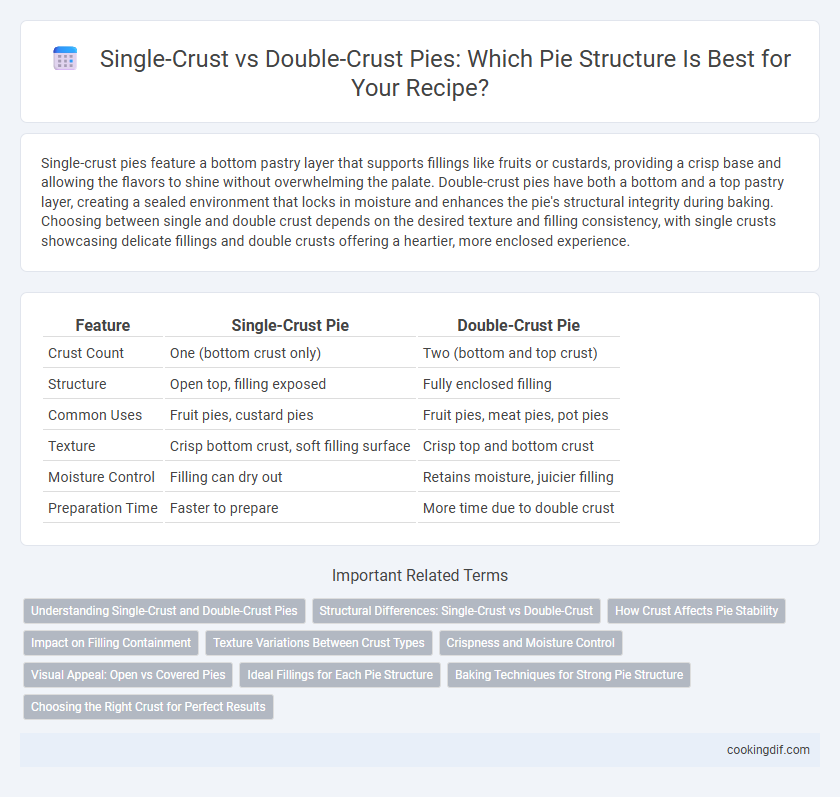Single-crust pies feature a bottom pastry layer that supports fillings like fruits or custards, providing a crisp base and allowing the flavors to shine without overwhelming the palate. Double-crust pies have both a bottom and a top pastry layer, creating a sealed environment that locks in moisture and enhances the pie's structural integrity during baking. Choosing between single and double crust depends on the desired texture and filling consistency, with single crusts showcasing delicate fillings and double crusts offering a heartier, more enclosed experience.
Table of Comparison
| Feature | Single-Crust Pie | Double-Crust Pie |
|---|---|---|
| Crust Count | One (bottom crust only) | Two (bottom and top crust) |
| Structure | Open top, filling exposed | Fully enclosed filling |
| Common Uses | Fruit pies, custard pies | Fruit pies, meat pies, pot pies |
| Texture | Crisp bottom crust, soft filling surface | Crisp top and bottom crust |
| Moisture Control | Filling can dry out | Retains moisture, juicier filling |
| Preparation Time | Faster to prepare | More time due to double crust |
Understanding Single-Crust and Double-Crust Pies
Single-crust pies feature a single layer of pastry that forms the base, providing a sturdy foundation that holds fillings such as custards or fruit without a top crust, enhancing the filling's visibility and texture. Double-crust pies have both a bottom and a top pastry layer, enclosing the filling completely, which seals in moisture and flavors, commonly used for fruit pies to create a golden, flaky exterior. Understanding the difference in structure helps in selecting the ideal crust type based on the desired presentation, texture, and flavor retention for specific pie recipes.
Structural Differences: Single-Crust vs Double-Crust
Single-crust pies feature a bottom pastry layer only, supporting the filling while maintaining a lighter, flakier texture ideal for fruit or custard fillings. Double-crust pies incorporate both a bottom and a top crust, creating a sealed structure that traps steam and enhances moisture retention, making them suitable for rich, juicy fillings like apple or cherry. The structural distinction affects baking time, texture, and the pie's ability to contain fillings without leakage.
How Crust Affects Pie Stability
Single-crust pies rely on a sturdy bottom crust to support the filling, ensuring a firm base that prevents sogginess and maintains structural integrity during baking. Double-crust pies use both top and bottom crusts, creating a sealed environment that enhances stability by holding the filling in place and preventing leakage. The choice between single-crust and double-crust pie significantly impacts stability, with double-crust pies generally offering greater support for juicy or loose fillings.
Impact on Filling Containment
A single-crust pie features a bottom crust only, which effectively contains moist fillings but may allow juices to bubble over during baking. A double-crust pie, with both top and bottom crusts, provides superior filling containment by sealing in moisture and preventing spills. This structure also helps retain the pie's shape and enhances the overall texture by evenly distributing heat around the filling.
Texture Variations Between Crust Types
Single-crust pies have a tender, flaky bottom crust that crisps during baking, offering a light, delicate texture that enhances the pie filling's flavor. Double-crust pies feature both a bottom and a top crust, creating a contrast between the soft, often fruit-laden interior and the golden, slightly chewy top layer. This textural variation adds complexity and a heartier bite, appealing to those who enjoy a balance of crispness and softness in each slice.
Crispness and Moisture Control
Single-crust pies excel in maintaining a crisp, flaky crust by exposing the filling directly to heat, which allows excess moisture to evaporate effectively. In contrast, double-crust pies trap moisture between two layers, resulting in a moister filling but risking a soggier bottom crust. Optimal pie structure balances crispness and moisture control based on crust layering, ensuring a satisfying texture and preventing crust sogginess.
Visual Appeal: Open vs Covered Pies
Single-crust pies showcase vibrant fruit fillings through their open tops, enhancing visual appeal with colorful, glossy surfaces that invite immediate appetite. Double-crust pies offer a uniform, golden-brown exterior that emphasizes a classic, rustic look while concealing the filling, adding an element of surprise. The choice between open and covered pies affects not only texture and moisture retention but also the pie's aesthetic impact on presentation.
Ideal Fillings for Each Pie Structure
Single-crust pies, featuring a single bottom pastry, are ideal for moist fillings like custards, creams, or fresh fruits such as berries and peaches, as the open top allows steam to escape and prevents sogginess. Double-crust pies, with both top and bottom pastry layers, are better suited for thicker, chunkier fillings like apple, cherry, or meat mixtures, providing a sealed structure that traps steam and enhances flavor melding. Choosing the right crust structure depends on the filling's moisture content and texture to maintain a crisp crust and balanced pie consistency.
Baking Techniques for Strong Pie Structure
Single-crust pies benefit from blind baking to prevent sogginess, ensuring a crisp, firm base that supports fillings without structural collapse. Double-crust pies require careful sealing of edges and venting of top crust to maintain shape and allow steam to escape, preventing soggy interiors and soggy tops. Using lattice or crimped edges adds reinforcement, promoting even heat distribution and a robust, flaky texture in both pie types.
Choosing the Right Crust for Perfect Results
Single-crust pies feature a single layer of pastry that serves as the base, ideal for fruit fillings that require ventilation during baking to prevent sogginess. Double-crust pies, with both a bottom crust and a top layer, provide a sealed enclosure suitable for thick fillings like custards or meat, ensuring moisture retention and enhanced flavor blending. Selecting between single and double crusts depends on filling type, baking method, and desired texture, directly impacting the pie's structural integrity and taste.
Single-crust pie vs double-crust pie for pie structure Infographic

 cookingdif.com
cookingdif.com